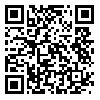BibTeX | RIS | EndNote | Medlars | ProCite | Reference Manager | RefWorks
Send citation to:
URL: http://jdisabilstud.org/article-1-2888-en.html
2- Assistant Professor, Department of Psychology, Shahrood Branch, Islamic Azad University, Shahrood, Iran
3- Assistant Professor, Department of Psychology, Tafresh Branch, Islamic Azad University, Tafresh, Iran
Abstract
Background & Objectives: The most common eating disorder is binge eating, which is seen in obese or overweight people. Therefore, investigating the role of different variables in people with binge eating symptoms seems necessary. The increase in eating disorders in the second half of the 20th century is astonishing and is not culture–specific but becoming global. This disorder used to be a problem in Western countries, but today, China and Japan are as affected as America is. In addition, the gender and age of people with this disorder are distinctive, and this topic makes the investigation of their causes more interesting. Regarding the etiology of this disorder, unlike most other disorders, social and cultural factors play a more significant role than psychological and biological factors. Therefore, the present study aimed to present a model of irrational eating beliefs based on cognitive distortion with the mediating role of sensitivity to rejection in people with binge eating symptoms.
Methods: This research is analytical in nature and uses structural equation modeling. The statistical population of this study comprised all people with symptoms of binge eating who were referred to counseling centers in districts 6 and 12 of Tehran City, Iran, in 2021. To select the sample size in modeling research, 15 people are needed for each obvious variable. Considering 7 obvious variables in the conceptual model, 105 people were required in this research. However, due to the dropout and the possibility of not completing all the questions of the questionnaires by the participants, 200 questionnaires were distributed among the study population. Of whom, 185 questionnaires were completed, returned, and analyzed. Scales were used to collect data. The criteria for entering the research included obtaining a higher than average score in the Binge Eating Severity Questionnaire, bearing at least a diploma level of education, subjects not suffering from a specific physical disease or psychological disorder, and not undergoing psychological treatment or particular medication. The exclusion criterion included non–cooperation in completing the questionnaires. The study data were gathered via the Interpersonal Cognitive Distortions Scale (Hamamci & Büyüköztürk, 2004), Rejection Sensitivity Scale (Downey & Feldman, 1996), and Irrational Food Beliefs Questionnaire (Osberg et al., 2008). The Pearson correlation and structural equation modeling were used for data analysis in SPSS version 24 and Amos version 24. The significance level of all tests was set at 0.05.
Results: Examining the coefficients of the direct relationships between different paths showed that cognitive distortion and sensitivity to rejection (p<0.001, β=0.55) and sensitivity to rejection and irrational eating beliefs (p<0.001, β=0.61) had a significant direct relationship. However, there was no direct relationship between cognitive distortion and irrational eating beliefs (p=0.968, β=0.003). Also, the indirect effect of cognitive distortion on irrational eating beliefs with the mediating role of sensitivity to rejection was equal to 0.065 (p=0.001). The goodness of fit indices of the fitted conceptual model were as follows: CMIN/df=3.09, GFI=0.96, NFI=0.97, and RMSEA=0.082.
Conclusion: According to the results of the study, sensitivity to rejection in people with binge eating symptoms mediates the relationship between cognitive distortions and irrational eating beliefs.
| Rights and permissions | |
 |
This work is licensed under a Creative Commons Attribution-NonCommercial 4.0 International License. |



